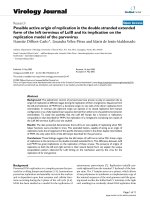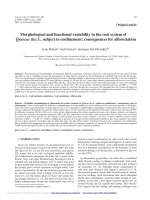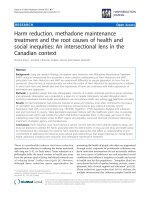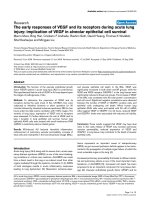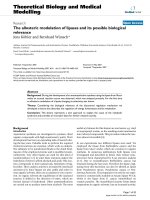An investigation on the root system of mangroves and its influence on current flow
Bạn đang xem bản rút gọn của tài liệu. Xem và tải ngay bản đầy đủ của tài liệu tại đây (14.35 MB, 256 trang )
AN INVESTIGATION ON THE ROOT SYSTEM OF
MANGROVES AND ITS
INFLUENCE ON CURRENT FLOW
ZHANG XIAOFENG
NATIONAL UNIVERSITY OF SINGAPORE
2014
AN INVESTIGATION ON THE ROOT SYSTEM OF
MANGROVES AND ITS
INFLUENCE ON CURRENT FLOW
ZHANG XIAOFENG
(B.Eng, Hohai University, China)
A THESIS SUBMITTED
FOR THE DEGREE OF DOCTOR OF PHILOSOPHY
DEPARTMENT OF CIVIL & ENVIRONMENTAL
ENGINEERING
NATIONAL UNIVERSITY OF SINGAPORE
2014
DECLARATION
I hereby declare that this thesis is my original work and has been written by me in
its entirety. I have duly acknowledged all the sources of information which have been
used in the thesis.
This thesis has also not been submitted for any degree in any university previously.
………………………………………………
Xiaofeng ZHANG
10
th
August, 2014
i
ACKNOWLEDGEMENT
The four years doctorate study in NUS is a training for me. It helps me to increase
my confidence, broaden horizons and gain skills. I am indeed very fortunate to have
the support and encouragement of my supervisors and friends.
My deepest gratitude goes first and foremost to Emeritus Professor Cheong Hin
Fatt, my main supervisor, for his constant guidance and encouragement. He has walked
me through all the stages of my four-year study. I learn the critical attitude and rigorous
scholarship in research from him, since he never let every tiny problem go and tried to
solve it promptly. I enjoy every conversation with him, because his research ideas, life
philosophy, humorous stories and even investment concepts always inspire me. Second,
I would like to express my heartfelt gratitude to my co-supervisor Assistant Professor
Vivien, Chua Pei Wen, who had diligently guided me through the numerical simulation
and pushed me for the publications. Without her encouragement, this thesis could not
have reached its present form.
I also like to thank my thesis committee members, Associate Professors Liong Shie
Yui and Vladan Babovic for their valuable inputs at various stages of my study.
I have also benefitted from the course work study at NUS. I am indebted to all
faculty members whose course I have attended. I am especially grateful to Dr. Bai Wei,
Prof Gustaaf Stelling, Prof Eatock Taylor and Associate Professor Meng Qiang, who
offered great courses on wave hydrodynamics, oceanography, coastal processes,
sediment transport and computational fluid dynamics which were very useful for my
thesis study.
My thesis study was financially supported by SDWA (Singapore-Delft Water
Alliance) Marine Project and the Open Fund of State Key Laboratory of Hydraulic and
River Mountain Engineering in Sichuan University. I would like to acknowledge the
colleagues and final year project students, Seow Soon Leong, Leong Mei Lin, Jiang
Bo, Nazreen B Osman, Lew Zi Xian and Ma Xinyue, who joined the SDWA marine
project for their assistance in the mangrove field work. I also want to thank the persons
in this marine project: Prof Cheong Hin Fatt, Dr. Liew Soo Chin, Dr. Chew Soon Hoe
and Dr. Lim Guan Tiong, for their guidance in our mangrove research and their treats
for our seafood dinners during Malaysia fieldtrips.
ii
I also owe a special debt of gratitude to Professor Lin Pengzhi, for his support and
valuable discussion when I was in Sichuan University as a visiting student. I also want
to thank Prof Lin’s students in SCU during my stay in their laboratory, and they are
Zhang Guanqing, Cai Shujuan, Han Xun, Tang Xiaochun, Dr. Liu Xin and Cheng Lin.
I feel comfortable to work with them and it is important to have their selfless help in
my experiments preparation and data collection. I miss the Sichuan mala hot pot all the
time and I wish everything goes well with their study and career.
The unrelenting support of the technical staff at the NUS Hydraulic Laboratory is
gratefully appreciated. Mr. Krishna and Mr. Shaja assisted in many ways, including
contacting the fabrication contractors and assistance in the physical modelling of flume
experiments. Mr. Semawi and Mr. Roger Koh also assisted in the physical model
fabrication, flume cleaning and instrument installation. I would like to thank Dr. Jahid
Hasan at SDWA for helping me with Delft3D-FLOW and Dr. Dan Friess at Department
of Geography for valuable introduction of mangroves to me.
I am happy to thank my classmates and friends in Singapore: Trinh Dieu Huong,
Serene Tay, Zhang Lei, Feng Xingya, Zheng Jiexin and Huang Jun. The friendly air
formed by all of these people makes the study at NUS a pleasant time. Special thanks
are to Dr. Lim Kian Yew for the fruitful discussion of research and experiment with
me, to Kwong Wen Zee for his patient help during my flume experiments and to Dr.
Chen Haoliang for his tutoring of the porous media numerical model to me.
Finally, I like to express the gratitude from my heart to my parents, who have been
giving me the endless support and understanding in my life. I also like to thank my
girlfriend Chen Qiyu for her love, care and patience. You are iridescent to me and
nothing will ever compare. I could not finish the study without the supports from all of
them.
iii
TABLE OF CONTENTS
ACKNOWLEDGEMENT I
TABLE OF CONTENTS III
ABSTRACT IX
NOMENCLATURE XI
LIST OF FIGURES XV
LIST OF TABLES XXII
CHAPTER-1 INTRODUCTION TO MANGROVE
HYDRODYNAMICS AND THE PRESENT STUDY 1
1.1 General Description of Mangrove Hydrodynamics 1
1.2 Literature Review 3
1.2.1 Field observations 3
1.2.2 Flume experiments 9
1.2.3 Numerical studies 15
1.3 Objective 18
1.4 Research Questions and Thesis Structure 20
CHAPTER-2 GEOMETRICAL AND MATERIAL PROPERTIES OF
PNEUMATOPHORES AND PROP ROOTS 23
2.1 Study Methods of Pneumatophores 23
2.1.1 Site description 23
2.1.2 Photogrammetry 25
2.1.3 Material tests 27
2.1.4 Rigidity determination 30
2.2 Results of Pneumatophores 33
2.2.1 Spatial distribution 33
2.2.2 Geometrical properties 34
2.2.3 Material properties 36
iv
2.2.4 Rigidity of pneumatophores under hydrodynamic loadings 37
2.3 Study Methods of Prop Roots 41
2.3.1 Geometrical properties 41
2.3.2 Material properties 42
2.4 Results of Prop Roots 43
2.4.1 Geometrical properties of prop roots 43
2.4.2 Prop root ordering and modeling method 45
2.4.3 Material properties of prop roots 48
2.5 Chapter Conclusion 49
CHAPTER-3 EXPERIMENTAL SERIES, SETUP AND METHODS 51
3.1 Summary of Experiments 51
3.2 NUS Current Flume, Equipment and Instrumentation 55
3.2.1 NUS current flume and setups 55
3.2.2 Acoustic Doppler Velocimeter (ADV) 56
3.2.3 Capacitance-type wave gauges 57
3.2.4 Force balance 58
3.2.5 Duration of velocity and force measurements 62
3.2.6 Mangrove pneumatophores model 63
3.2.7 Mangrove prop root model 64
3.3 SCU Current Flume, Equipment and Instrumentation 66
3.3.1 SCU current flume and setups 66
3.3.2 Pneumatophores model and other instruments 67
3.3.3 Particle Image Velocimeter (PIV) 68
3.3.4 PIV algorithm 71
3.3.5 Procedures of PIV measurements 72
3.3.6 Fully developed flow region 75
CHAPTER-4 EXPERIMENTAL STUDY OF FLOW OVER
PNEUMATOPHORES MODEL 77
4.1 Mean Flow Structure 77
4.1.1 Water surface fluctuations 77
4.1.2 Vertical spatial variation of velocity 79
4.1.3 Double-averaged velocity profile 84
4.2 Reynolds Stress 88
4.2.1 Double-averaged Reynolds stress 88
v
4.2.2 Reynolds stress in uniform two-dimensional flow 92
4.2.3 Penetration depth 96
4.2.4 Spatial variation of penetration depth 97
4.3 Turbulent Structure 98
4.3.1 Vertical spatial variation of turbulence 98
4.3.2 Double-averaged turbulent structure 102
4.3.3 Phase-averaged turbulent structure 107
4.4 Drag Coefficients of Clusters of Pneumatophores 114
4.4.1 Direct force measurement method 114
4.4.2 Direct force measurement results 116
4.4.3 Drag coefficients of rods clusters 119
4.4.4 Comparison with momentum balance method 121
4.5 Chapter Conclusion 123
CHAPTER-5 EXPERIMENTAL STUDY OF FLOW OVER PROP
ROOTS MODEL 127
5.1 Experimental Methods 127
5.2 Flow Transition 130
5.2.1 Approaching flow conditions 130
5.2.2 Flow establishment in mangrove prop roots 132
5.3 Mean Flow Structure 134
5.3.1 Streamwise velocity measurements 134
5.3.2 Transverse and vertical velocity measurements 139
5.4 Turbulent Structure and Flow Resistance 141
5.4.1 Turbulent kinetic energy measurements 141
5.4.2 Flow resistance 143
5.5 Chapter Conclusion 144
CHAPTER-6 NUMERICAL VALIDATION AGAINST FLUME
EXPERIMENTAL RESULTS 147
6.1 Introduction of Numerical Model 147
6.1.1 Governing equations 147
6.1.2 Vegetation module and turbulence model 148
6.2 Model Setup and Calibration 150
6.2.1 Grids, time step and boundary conditions 150
vi
6.2.2 Mangrove roots input 152
6.2.3 Validation with flow over gravels 153
6.3 Numerical Simulation Results 156
6.3.1 Flow through emergent pneumatophores 156
6.3.2 Flow over submerged pneumatophores 157
6.3.3 Flow through prop roots 161
6.4 Chapter Conclusion 164
CHAPTER-7 SUMMARY, CONCLUSIONS AND
RECOMMENDATIONS 165
7.1 Research Summary 165
7.2 Conclusion 166
7.3 Recommendations 170
7.3.1 Mangrove roots structure studies 170
7.3.2 Mangrove hydrodynamic studies 170
7.3.3 Mangrove environmental studies 171
BIBLIOGRAPHY 173
APPENDICES 187
APPENDIX A PRELIMINARY TESTS OF FLOW OVER GRAVEL
BED IN NUS FLUME 187
1. Alignment and positioning of instruments 187
2. Flow resistance of uniform gravels bed 190
APPENDIX B PRELIMINARY TESTS OF FLOW OVER SMOOTH
BED IN SCU FLUME 193
1. Comparison between ADV and PIV 193
2. Flow resistance of smooth bed 195
APPENDIX C TRANSVERSE OSCILLATIONS IN CUURENT
FLOW THROUGH RIGID EMERGENT RODS 197
1. Introduction 197
1.1 Phenomenon of transverse oscillations 197
1.2 Resonance theory 198
2. Experimental Results 201
2.1 Transverse wave frequencies and amplitudes 201
vii
2.2 Influence to main current flow 204
2.3 Less disturbed horizontal time-averaged velocity field 207
2.4 Less disturbed mean streamwise velocity profile 209
2.5 Periodic flow pattern 211
3. Formula for Wave Amplitude Prediction 215
3.1 Previous formulae 215
3.2 Proposed formula using momentum balance 215
3.3 Results of wave amplitude prediction 221
4. Phase Averaging 223
4.1 Phase averaging method 223
4.2 Phase averaging results 226
5. Conclusion and Recommendation 227
viii
ix
ABSTRACT
The mangrove swamps and its creek system are truly masterpieces of nature’s
ecological engineering. The circulation of water in riverine mangrove swamps is
expected to be influenced by the mangrove roots, which in turn affect the transport of
nutrients, pollutants and sediments in these systems. An investigation into the
geometrical and material characteristics of mangrove roots, including pneumatophores
and prop roots was performed first in this study to improve our understanding of
physical processes in mangrove ecosystems. Field studies were carried out in mangrove
areas along the coastlines of Singapore. The geometrical and material properties of
mangrove pneumatophores and prop roots were assessed through the use of
photogrammetric methods and structural tests in laboratory. It was found that for both
mangrove roots in a normal tidal environment, they can be regarded as rigid structures
under riverine hydrodynamic loadings based on resonance and deflection calculations.
Four sets of flume experiments for pneumatophores were conducted, including (1)
current flow through emergent pneumatophore models; (2) depth-limited flow over
submerged pneumatophore models; (3) deep water flow over submerged models and
(4) direct drag force measurements of emergent pneumatophore clusters. The double-
averaged measurements of velocities and velocity fluctuations were obtained through
the area-temporal-averaging from PIV data and temporal-averaging from ADV data at
the representative measurement points. Under certain experimental conditions for the
flow through emergent pneumatophores (1), it was found that a transverse standing
wave pattern was set up in the flume when this phenomenon is not observed in the field.
This standing wave was studied and the phase-averaging method was proposed to
eliminate the wave influence in main current flow. In the experiment scenario (2) and
(3), the pneumatophores influence to current flow over an entire tidal period was
simulated by changing the submergence of water flow over pneumatophore models. It
is found that the velocity and turbulence parameters are spatial dependent deep inside
the roots, but they are homogenous everywhere if the flow submergence is large. In the
experiment scenario (4), drag coefficients were obtained and compared with different
simulated arrangements of pneumatophore clusters in a mangrove environment using
direct force balance measurements.
x
For mangrove prop roots, a stream ordering scheme was employed in order to
construct the physical models used in the flume experiments. The models were
downscaled based on field observations with changing porosity values ranging from
0.96 to 0.98 with depth. Flume experiments were performed and measurements of flow
velocities were made using ADV. The results indicate that the prop roots provide more
blockage effect than pneumatophore models on the main current flow and cause
complex secondary flows. The turbulence energy is generated by the combination of
wake and shear, and the water flow through prop roots is highly three-dimensional and
non-homogenous. A force balance analysis was performed in the nearly uniform flow
region to investigate the flow resistance caused by the prop root models. The Chezy
roughness coefficient was found to be around 10 and the drag coefficient was found to
be 1.2-1.8 in the fully developed uniform flow, which agrees with reported field studies
in mangrove swamps.
Finally, Delft3D based on double-averaging scheme was adapted. The model-
predicted profiles for mean velocity and turbulent kinetic energy were calibrated and
compared with flume experimental data. The user-defined horizontal and vertical
background eddy viscosities were adjusted to give good predictions of mean velocity
and turbulent kinetic energy profiles. For the mangrove pneumatophore models, the
prediction of mean velocity structures and turbulence characteristics in deep submerged
pneumatophores condition is better than those found in shallow submerged situation,
since the wake layer does not exist. For the prop root models, numerical model provides
a satisfactory prediction for the mean flow structure. However it is limited in the
simulation of turbulent structure as the model based on porous media assumption
cannot effectively account for the anisotropic turbulence in such mangrove prop roots
environment.
xi
NOMENCLATURE
Roman symbols
A
cross sectional area of mangrove roots/rectangular flumes
A
P
projected area of mangrove root cluster
a
wave amplitude
B
width of rectangular flumes
C
Chezy roughness coefficient
C
D
drag coefficient
C
L
lift coefficient
c
wave phase celerity
D
diameter of cylinders in physical mangrove roots model
D
bh
diameter at breast height of tree trunk
D
r
external diameter of Rhizophora stylosa root (inclusive of bark)
D
s
external diameter of Sonneratia alba root (inclusive of bark)
D
sw
diameter of woody core of Sonneratia alba root
d
the zero plane displacement of the logarithmic profile
E
Young’s modulus/modulus of elasticity
F
D
drag force
F
L
lift force
F
r
Froude number
f
friction factor/frequency of vibration
f
s
forcing frequency in vortex induced vibration
f
n
natural frequency in vortex induced vibration
g
gravital acceleration=9.81 m
2
/s
H
wave height
h
water depth
I
second axial moment of area about neutral axis
k
mangrove roots height/ wave number
k
n
equivalent Nikuradse sand grain roughness
k
r
mangrove prop root system height
k
s
dimension of a physical roughness element
L
length of a prop root/ height of a pneumatophore/wave length
L
e
establishment length for uniform flow
l
length of root sample during tensile/bending tests
xii
l
0
initial length of root sample before tensile/bending tests
M
mass flux
M
E
number of aluminum rods attached to suspended drag plate
m
spatial density of mangrove roots
N
number of model cylinders per one row in flume
N
S
measurement sample size
n
Manning’s roughness coefficient/ wave oscillation mode
P
applied loadings in root structural tests
p
pressure of fluid
Q
flow rate
R
regression coefficient
Re
Reynolds number
R
B
branching ratio of prop roots in stream ordering scheme
R
D
diameter ratio of prop roots in stream ordering scheme
S
centerline spacing between model roots in one row/ energy slope
S
0
flume bottom slope
St
Strouhal number
T
centerline spacing between rows of model roots/ wave period
U
local mean streamwise velocity
U
Q
bulk velocity in x-direction/mean streamwise velocity in flume
u
instantaneous velocity in the streamwise x-direction
uꞌ
turbulent velocity fluctuation in x-direction
u
*
streamwise shear velocity
V
mean transverse velocity in flume
v
instantaneous velocity in the transverse y-direction
vꞌ
turbulent velocity fluctuation in y-direction
W
mean vertical velocity in flume
W
r
geometrical width of the prop root system
w
instantaneous velocity in the vertical z-direction
wꞌ
turbulent velocity fluctuation in z-direction
x
coordinate direction of the current
y
direction orthogonal to current and parallel to the flume bottom
z
elevation from the flume bed
z
0
roughness length from the log-profile analysis
volume of a control volume/total volume
m
volume occupied by mangrove roots
∆
longitudinal length occupied by one row of cylinders
xiii
Greek symbols
constant in the first-mode vibration equation
coefficient in fluid momentum equation
deflection of mangrove roots/current boundary layer thickness
engineering strain/dissipation rate of turbulence
von Karman’s constant=0.4
tensile stress/wave frequency
a physical variable
time averaged physical variable
fluctuation of a physical variable from its time averaged value
deviation of a physical variable from its volume averaged value
kinematic viscosity
turbulent eddy viscosity
water surface elevation
porosity
mass density of mangrove roots/water
shear stress
xiv
xv
LIST OF FIGURES
Figure 1-1 World mangrove forests distribution (National Geographic Magazine, in
2007). 4
Figure 1-2 Photographs of mangrove pneumatophores (a), taken at Berlayer Creek,
Singapore, knee roots (b), by Paul Marek, taken in Australia and prop roots
(c), taken at Kranji Reservoir, Singapore. 4
Figure 1-3 Pneumatophores on cable roots radiating from a single Sonneratia alba,
penetrating through the tidal mudflat in Malaysia's Bako National Park
(Photograph by Tim Laman, National Geographic, Feb 2007). 5
Figure 1-4 Schematic plan view of the current flow directions and hydrodynamics in a
riverine-type mangrove forest (Mazda et al., 2005). 8
Figure 1-5 Flow velocity profiles for (a) deeply submerged vegetation; (b) shallow
submerged vegetation and (c) emergent vegetation. 11
Figure 1-6 Streamwise velocity profiles and dominant turbulence scales are shown for
(a) a sparse canopy (mkD<<0.1), (b) a transitional canopy (mkD≈0.1), and
(c) a dense canopy (mkD
≥
0.23), where k is the submerged canopy height.
For mkD
≥
0.1, a region of strong shear at the top of the canopy generates
canopy-scale turbulence. Stem-scale turbulence is generated within the
canopy (Nepf, 2012a). 12
Figure 1-7 Two parallel storylines in studying mangrove pneumatophores and prop
roots in this thesis and their corresponding chapter numbers. 22
Figure 2-1 (c) Plan view of five surveyed Sonneratia alba with their pneumatophores
(dots) in Berlayer Creek (1°15'N, 103°48'E), Singapore, during a spring low
tide. The digits in brackets indicate the spatial density i.e. the number of
pneumatophores/m
2
within the quadrate. The entire area is covered with
pneumatophores, and the small dots in the figure are only for illustration
purpose. They do not indicate the actual positions and number of
pneumatophores. (d) Photograph of Berlayer Creek in Singapore is taken
from the river mouth. 25
Figure 2-2 (a) Photogrammetric application for surveying mangrove pneumatophores
in a mangrove site. Picture shows two quadrates around a Sonneratia alba,
square panels were used for building three-dimensional coordinates. (b) A
Sonneratia alba with its pneumatophores, the tree was about 5 m away from
Berlayer Creek waterline during a low tide. 27
Figure 2-3 (a) Shimadzu machine with its control panel. (b) A Sonneratia alba root
sample was under tension and wires were connected to the strain gauges.
(c) A Sonneratia alba root sample was in its bending test. The cylinder in
the bottom was the point transducer to detect the vertical deflection. 28
Figure 2-4 Young’s modulus in tensile test (a) and modulus of elasticity in bending test
(b) were computed from the linear portions of stress-strain curves for root
tests. The linear portions were obtained using the least squares fit. 29
Figure 2-5 (a) Cross-sectional view of two prop roots with three layers, namely: (1)
bark, (2) woody annular ring, (3) inner marrow. (b) Cross-sectional view of
xvi
three pneumatophores with two layers, namely: (1) bark, (2) woody core.
D
r
, D
rw
and D
rm
refer to the diameters of entire prop root, woody ring and
inner marrow respectively, and D
s
and D
sw
are the diameters of entire
pneumatophore and its woody core, respectively. 30
Figure 2-6 A conical pneumatophore sample (left) harvested from the field, and a
truncated cone (right) for modeling pneumatophore with specified
geometrical parameters (not to scale). 32
Figure 2-7 Spatial density of pneumatophores in surveyed areas in Berlayer Creek,
Singapore. T - trees of Sonneratia alba, S - quadrates along creek edge and
M - quadrates between trees. Column height refers to the mean value of
roots spatial density based on the surveyed areas. Error bar indicates its
standard deviation among areas 33
Figure 2-8 Heights of mangrove pneumatophores in the surveyed areas in Berlayer
Creek, Singapore. T - trees of Sonneratia alba, S - quadrates along creek
edge and M – quadrates between trees. The horizontal dash lines indicate
the range of root mean heights in the surveyed areas. 34
Figure 2-9 Root diameter and moisture content variations along pneumatophore height
and prop root length. Filled dots: diameter and moisture measurements of
pneumatophore at eight different vertical positions along root height, from
base (0.0) to root tip (1.0). Error bar indicates the standard deviation based
on 50 samples. Empty dots: diameter and moisture measurements of prop
root at different positions along root length, from one side grown from trunk
(0.0) to the side anchored in ground (1.0). Error bar indicates the standard
deviation based on 10 samples. 35
Figure 2-10 Relationship between Strouhal number (St) and Reynolds number for
circular cylinders (Re). Data is from Lienhard (1966) and Achenbach and
Heinecke (1981). Graph from MIT Open Courseware. 38
Figure 2-11 The ratio of forcing frequency f
s
to the natural frequency f
n
of sample
pneumatophore (assumed to be a conical cantilever with homogenous
material distribution) under different current velocity. Resonance line
refers to the ratio of 1.0 between natural frequency and forcing frequency,
which means the resonance occur. 40
Figure 2-12 (a) Photogrammetric triangulation, XYZ coordinates determined from
intersecting rays; (b) A single young Rhizophora stylosa with markers and
feature points. Dots on prop roots: markers or feature points; retracting ruler:
scaling purpose; two square panels on ground: coordinates construction
(Zhang et al., 2012). 42
Figure 2-13 (a) Dimensions (average values) of prop root heights and diameters
computed based on twenty young Rhizophora stylosa in Singapore. Tree
drawing is from Elizabeth Farnsworth (with permission); (b) Relationship
between height (k
r
) and width (W
r
) of prop root system. Solid line indicates
k
r
=W
r.
Symbols: k
r
, height of submerged prop root system; W
r
, width of root
system; D
bh
, diameter of trunk at breast height; D
r1
, diameter of roots at
ordering 1; D
r2
, diameter of roots at ordering 2; D
r3
, diameter of roots at
ordering 3. 44
Figure 2-14 (a) Porosity θ (average values with standard deviation) of prop root
systems computed based on field measurements, compared with porosity
of artificial root model used in later flume experiments (in Chapter 5). (b)
The top views of two Rhizophora stylosa prop root systems footprint. The
total volume is defined as . 44
Figure 2-15 The principle of Strahler (1952) ordering scheme applied to a surveyed
Rhizophora stylosa prop root system. (a) Photo of a Rhizophora stylosa tree
xvii
with the ordered prop roots. (b) The corresponding 3D computer model of
that root system. 45
Figure 3-1 Sketches for all the current flume experimental scenarios in this study: flow
over (a) uniform gravels bed in NUS; (b) emergent pneumatophore models
in NUS; (c) submerged pneumatophore models in NUS; (d) prop roots
models in NUS; (e) PMMA (polymethyl methacrylate) pneumatophore
models in SCU using PIV measurements. Sketches are not drawn in scales.
53
Figure 3-2 Photograph of NUS current flume with uniform gravel bed (Black cylinder:
ADV Plus). 55
Figure 3-3 Cross sectional view of three roughness models in the NUS current flume,
(a) uniform gravel bed, (b) emergent mangrove pneumatophore models (1:1
scale), (c) mangrove prop root models. 56
Figure 3-4 An Acoustic Doppler Velocimeter (ADV) probe measuring underwater,
with a sampling volume 5 cm away from its emitter. 56
Figure 3-5 (a) Force balance setup with mounting plate and aluminum frame on the
NUS flume rails. Photograph shows the drag force measurement in a flow
over mangrove pneumatophores situation. (b) The force balance with its
mounting steel plate, zoom in for the rectangular dashed line area in (a).60
Figure 3-6 CAD design drawing for force balance setup and mounting in NUS current
flume. (a) Cross sectional view of flume, (b) Side view of force balance
setup at the longitudinal section (x=7.5 m) of flume. 61
Figure 3-7 Calibration curves for the force balance, study for linearity and sensitivity
to force induced moments at different applied positions. Pulling force
applied at different elevations, (a) bottom of PVC pipe mounted, (b) 1/3 of
PVC pipe height, (c) 2/3 of PVC pipe and (d) end of PVC pipe. 62
Figure 3-8 (a) Plan view photo of a submerged pneumatophore models (scale 1:2). The
model was made of mild steel. The thickness of base plate was 6 mm. (b)
Plan view photo of NUS flume covered with emergent pneumatophore
models (scale 1:1). Hollow aluminum rods were inserted into the previous
submerged model rods in order to achieve the extension in root height from
k=8 cm to k=30 cm. 64
Figure 3-9 (a) Physical artificial model of mangrove prop roots and knee roots used in
Fatimah et al. (2008) experiment. (b) Physical “real” clay mangrove models
and its parameterized root models in Husrin et al. (2012) laboratory test for
tsunami attention by mangrove forests. 66
Figure 3-10 (a) Design of the artificial Rhizophora sp. prop root model with its
dimensions in our study, A-A section is the side view section in (b); (b) Top
view and side view of the artificial Rhizophora sp. prop root model with its
dimensions. 66
Figure 3-11 The current flume at Sichuan University (SCU). 67
Figure 3-12 (a) Side view photo of mangrove pneumatophore models (scale 1:1) in the
SCU current flume. The model was made of plexiglass. (b) View from
below the bottom of SCU flume covered with pneumatophore models
(scale 1:1). The rods were painted black at the sections for PIV
measurements. 68
Figure 3-13 Particle Image Velocimetry (PIV) system and its components 69
Figure 3-14 Experimental setup of current flume and PIV arrangements, (a) the LLS is
vertical in setup A, (b) the LLS is horizontal in setup B. 70
xviii
Figure 3-15 Processed velocity vector field from PIV experiments at x=8.2 m, y= 0.425
m vertical LLS plane, when the water depth is 25 cm. Three black areas are
caused by the shadow effect from the frontal rods, LLS projects through the
rod in the center of figure. 72
Figure 3-16 Allocation patterns of vegetation elements (plexiglass rods) in top view for
measurement longitudinal position. LLS1-LLS7 straight lines refer to the
vertical laser light sheet projected from flume bottom, dots line with area
of 30 cm×30 cm refers to the laser light sheet in horizontal plane projected
from the flume sidewall. 73
Figure 3-17 Calibration PIV images for (a) vertical FOV example when water depth
h=25 cm (submerged), x=8.3 m and y=42.5 cm (LLS6), (b) horizontal FOV
example when water depth h=25 cm (submerged), x=8.3 m and z=5 cm. 74
Figure 3-18 (a) longitudinal evolution of mean streamwise velocity and turbulent
kinetic energy at x=5 m, 6 m, 7 m and 8 m in SCU flume. (b) Average
values with standard deviation of mean velocity and TKE based on three
longitudinal locations: x=6 m, 7 m and 8 m in SCU flume. 76
Figure 4-1 A time-series (100 s-120 s) of water level fluctuations (unit: mm) from the
walls of the SCU flume (submerged rods, h/k=1.25) and the water level
spectra (at left sidewall, y=50 cm) with its peak value location in Exp. C2.0.
78
Figure 4-2 A time-series (140 s-160 s) of water level fluctuations (unit: mm) from the
walls of the SCU flume (submerged rods, h/k=1.50) and the water level
spectra (at left sidewall, y=50 cm) with its peak value location in Exp. C3.0.
79
Figure 4-3 Locations (18 black dots) for profile extraction from PIV LLS (units: mm)
at SCU flume x=8.3 m. This top view of rods in SCU flume is a picture
zoomed in based on Figure 3-16. 80
Figure 4-4 Temporal mean streamwise velocity at (a) LLS1; (b) LLS2 and (c) LLS3 of
Exp. C2.0. Gray areas refer to the rods, blank areas refer to the shadows
(frontal rods block the camera sight). The LLS locations can be referred to
Figure 3-16. 82
Figure 4-5 Temporal mean vertical velocity at (a) LLS1; (b) LLS2 and (c) LLS3 of Exp.
C2.0. Gray areas refer to the rods, blank areas refer to the shadows (frontal
rods block the camera sight). The LLS locations can be referred to Figure
3-16. 83
Figure 4-6 Time-averaged streamwise velocity U in horizontal LLS at z=12 cm of Exp.
C2.0. The bulk velocity U
Q
is identified in the legend. The horizontal LLS
area in SCU flume can be referred to Figure 3-16. 85
Figure 4-7 Temporal mean streamwise velocity profiles extracted from 18 observed
locations at PIV LLS1, LLS2 and LLS3, compared to double-averaging
velocity profile of Exp. C2.0. The 18 extracted locations refer to Figure 4-
3. 86
Figure 4-8 Temporal mean streamwise velocity profiles extracted from 18 observed
locations at PIV LLS1, LLS2 and LLS3, compared to double-averaging
velocity profile of Exp. C3.0. The 18 extracted locations refer to Figure 4-
3. 87
Figure 4-9 Reynolds stress at (a) LLS1; (b) LLS2 and (c) LLS3 of Exp. C2.0. Gray
areas refer to the rods, blank areas in contour refer to the shadows (frontal
rods block the camera sight). The LLS locations can be referred to Figure
3-16. 89
xix
Figure 4-10 Reynolds stress
uv
(unit: m
2
/s
2
) distribution in horizontal LLS at z=12
cm of Exp. C2.0. Gray areas refer to the rods, blank areas in contour refer
to the shadows (frontal rods block the laser light). 91
Figure 4-11 Reynolds stress profiles extracted from the observed locations at PIV (a)
LLS1, (b) LLS2 and (c) LLS3, compared to double-averaging Reynolds
stress profile in Exp. C2.0. The extracted locations refer to Figure 4-3 . 94
Figure 4-12 Reynolds stress profiles extracted from the observed locations at PIV (a)
LLS1, (b) LLS2 and (c) LLS3, compared to double-averaging Reynolds
stress profile in Exp. C3.0. The extracted locations refer to Figure 4-3. 95
Figure 4-13 Streamwise turbulence intensity at (a) LLS1; (b) LLS2 and (c) LLS3 of
Exp. C2.0. Gray areas refer to the rods, blank areas refer to the shadows
(frontal rods block the camera sight). The LLS locations can be referred to
Figure 3-16. 100
Figure 4-14 Vertical turbulence intensity at (a) LLS1; (b) LLS2 and (c) LLS3 of Exp.
C2.0. Gray areas refer to the rods, blank areas refer to the shadows (frontal
rods block the camera sight). The LLS locations can be referred to Figure
3-16. 101
Figure 4-15 Turbulence intensity at (a) streamwise direction; (b) transverse direction
(c) RMS of u and v direction in Exp. C2.0. Gray areas refer to the rods,
blank areas in contour refer to the shadows (frontal rods block the camera
sight). 104
Figure 4-16 The laser intersecting line (with three velocity components information)
formed by applied horizontal LLS (with u and v information) and vertical
LLS (with u and w information). 105
Figure 4-17 Profiles of double-averaged turbulence intensities of u and v based on
horizontal LLS planes, lines-temporal averaged turbulence intensities of u
and w based on 6 LLS lines (LLS1-6) and the square root of the TKE
(without multiply by 1/2) obtained from both PIV and ADV for (a) Exp.
C2.0, h/k=1.25 and (b) Exp. C3.0, h/k=1.50. 107
Figure 4-18 Sequences of the mean velocity vectors at six times t over a vortex
shedding cycle (T=0.83 s). The velocity field is selected behind a rigid rod
at x=8.35 m, y=flume centerline and z=12 cm in Exp. C2.0. 109
Figure 4-19 Sequences of the mean flow streamlines at six times t over a vortex
shedding cycle (T=0.83 s). The velocity field is selected behind a rigid rod
at x=8.35 m, y=flume centerline and z=12 cm in Exp. C2.0. 110
Figure 4-20 Fourier transforms of time-series measurements of u and v velocity
components behind a rod at the six different locations: (a) C1, (b) C2, (c)
C3, (d) C4, (e) L1 and (f) R1. The six locations can be referred to Figure 4-
19a. 112
Figure 4-21 Drag plates with different arrangements of rods clusters attached to the
force balance at x=7.5 m and y=30 cm (center of flume) in the NUS flume
(units: mm) of Exp.1.1-Exp.3.1. 115
Figure 4-22 Photograph of two rods clusters attached to drag plates with arrangements
of 9 grid rods (Exp. F1.1, refer to Figure 4-21) and 13 staggered rods (Exp.
F2.1, refer to Figure 4-21). 116
Figure 4-23 A time-series of force balance output for F2.1 (refer to Figure 4-21) at
Re=1600. In total, 3000 force or momentum readings were collected for 30
s duration. 117
Figure 4-24 Direct measurement of drag force F(x) (N) as a function of Re for each test.
Vertical error bars show the standard deviation of mean force values among
five repeats in sampling. 117



